Law for Business Managers: Company, Employment, and Disputes Analysis
VerifiedAdded on 2022/12/29
|11
|3557
|79
Report
AI Summary
This report delves into critical areas of business law, providing a comprehensive overview of the roles and responsibilities of a sole director, the legal processes surrounding employee dismissal, and various methods of dispute resolution. The report begins by examining the duties of a sole director within a company, referencing relevant sections of the Companies Law of 2006. It then analyzes the process of dismissing an employee, including legal requirements such as reasonable notice periods and fair reasons for dismissal under the Employment Rights Act. Finally, the report explores alternative dispute resolution mechanisms. The report uses case scenarios to illustrate the practical application of these legal principles. This report is a valuable resource for students studying business law, offering insights into key legal concepts and their practical application in business management. This report is contributed by a student and published on Desklib, a platform providing AI-based study tools.
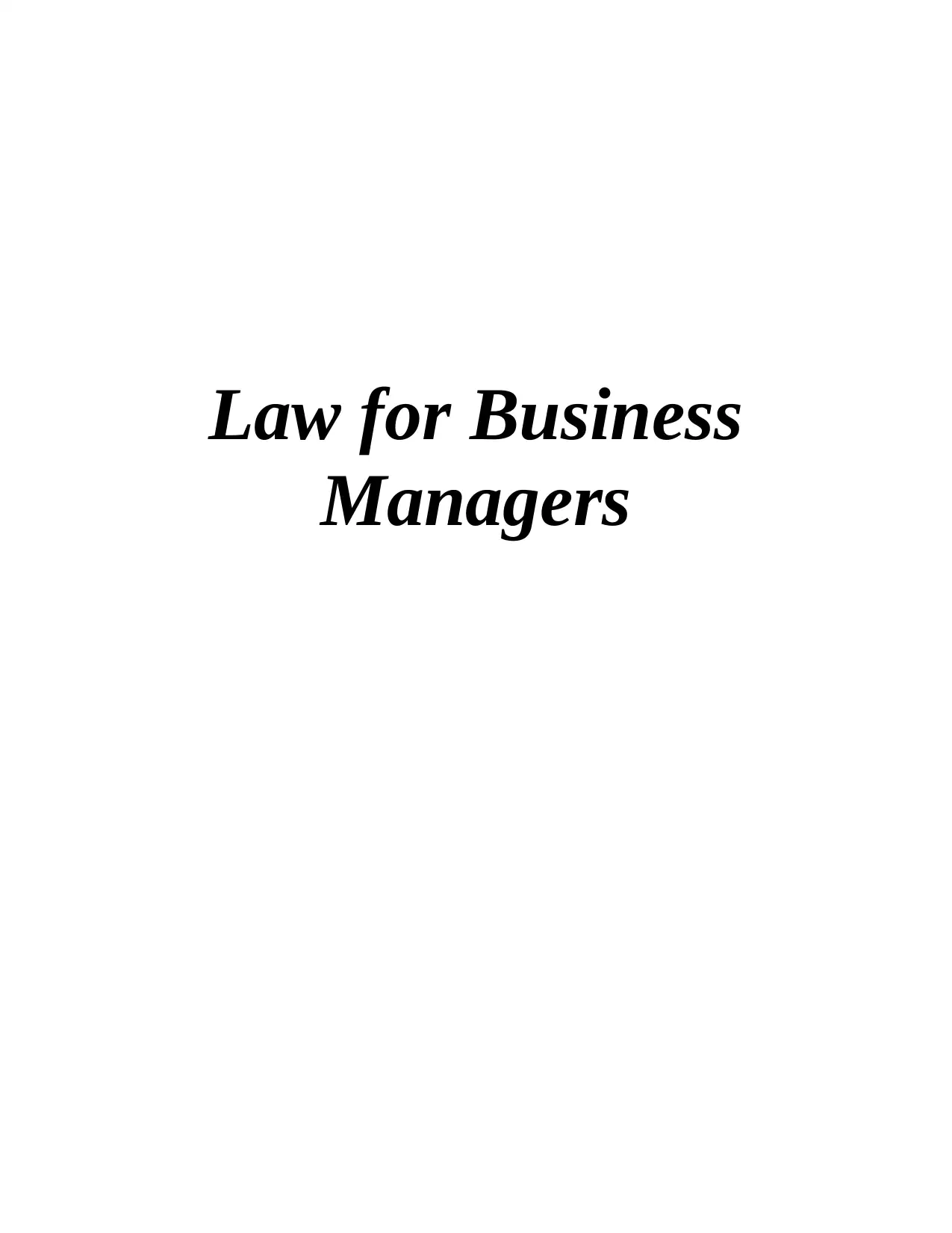
Law for Business
Managers
Managers
Paraphrase This Document
Need a fresh take? Get an instant paraphrase of this document with our AI Paraphraser
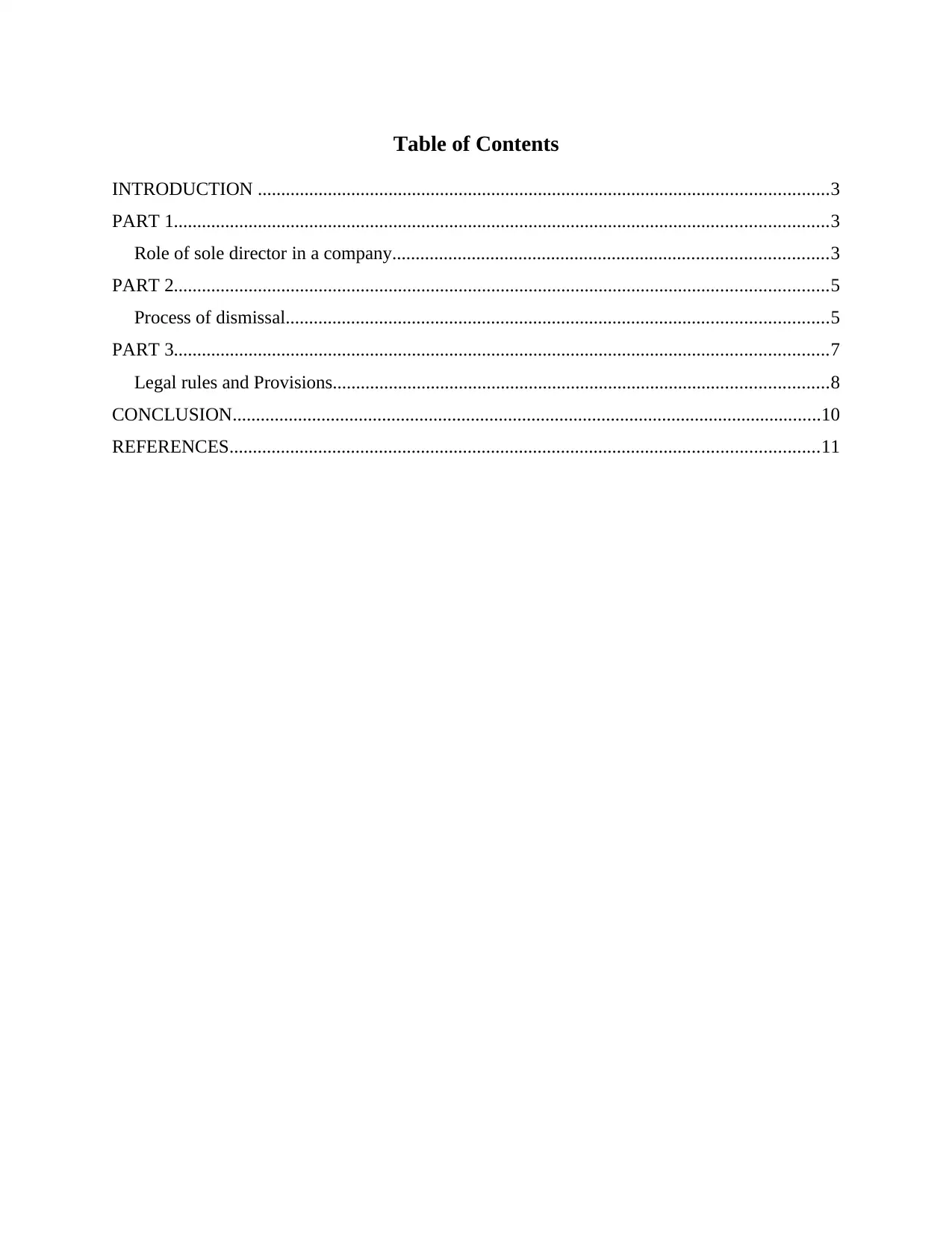
Table of Contents
INTRODUCTION ..........................................................................................................................3
PART 1............................................................................................................................................3
Role of sole director in a company.............................................................................................3
PART 2............................................................................................................................................5
Process of dismissal....................................................................................................................5
PART 3............................................................................................................................................7
Legal rules and Provisions..........................................................................................................8
CONCLUSION..............................................................................................................................10
REFERENCES..............................................................................................................................11
INTRODUCTION ..........................................................................................................................3
PART 1............................................................................................................................................3
Role of sole director in a company.............................................................................................3
PART 2............................................................................................................................................5
Process of dismissal....................................................................................................................5
PART 3............................................................................................................................................7
Legal rules and Provisions..........................................................................................................8
CONCLUSION..............................................................................................................................10
REFERENCES..............................................................................................................................11
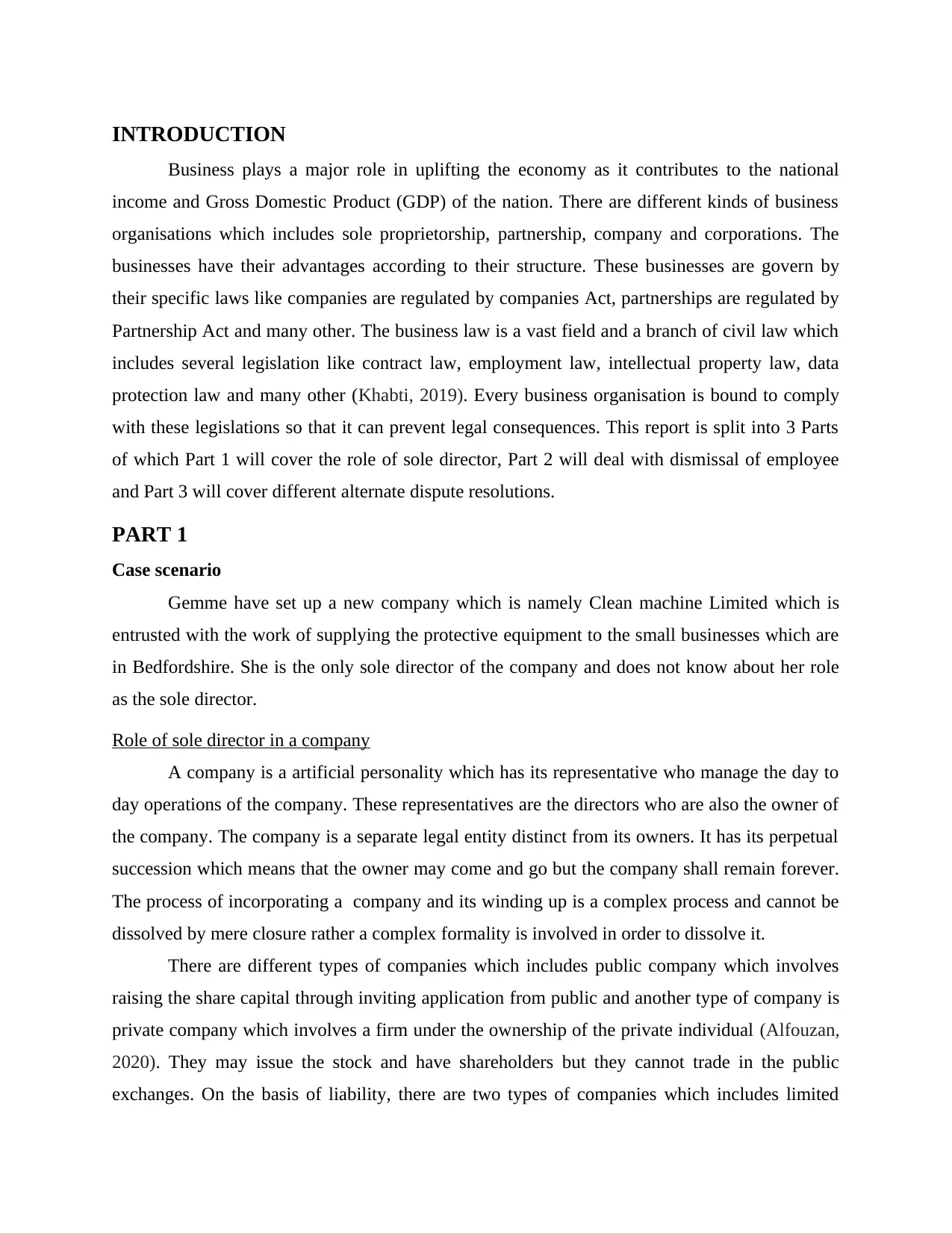
INTRODUCTION
Business plays a major role in uplifting the economy as it contributes to the national
income and Gross Domestic Product (GDP) of the nation. There are different kinds of business
organisations which includes sole proprietorship, partnership, company and corporations. The
businesses have their advantages according to their structure. These businesses are govern by
their specific laws like companies are regulated by companies Act, partnerships are regulated by
Partnership Act and many other. The business law is a vast field and a branch of civil law which
includes several legislation like contract law, employment law, intellectual property law, data
protection law and many other (Khabti, 2019). Every business organisation is bound to comply
with these legislations so that it can prevent legal consequences. This report is split into 3 Parts
of which Part 1 will cover the role of sole director, Part 2 will deal with dismissal of employee
and Part 3 will cover different alternate dispute resolutions.
PART 1
Case scenario
Gemme have set up a new company which is namely Clean machine Limited which is
entrusted with the work of supplying the protective equipment to the small businesses which are
in Bedfordshire. She is the only sole director of the company and does not know about her role
as the sole director.
Role of sole director in a company
A company is a artificial personality which has its representative who manage the day to
day operations of the company. These representatives are the directors who are also the owner of
the company. The company is a separate legal entity distinct from its owners. It has its perpetual
succession which means that the owner may come and go but the company shall remain forever.
The process of incorporating a company and its winding up is a complex process and cannot be
dissolved by mere closure rather a complex formality is involved in order to dissolve it.
There are different types of companies which includes public company which involves
raising the share capital through inviting application from public and another type of company is
private company which involves a firm under the ownership of the private individual (Alfouzan,
2020). They may issue the stock and have shareholders but they cannot trade in the public
exchanges. On the basis of liability, there are two types of companies which includes limited
Business plays a major role in uplifting the economy as it contributes to the national
income and Gross Domestic Product (GDP) of the nation. There are different kinds of business
organisations which includes sole proprietorship, partnership, company and corporations. The
businesses have their advantages according to their structure. These businesses are govern by
their specific laws like companies are regulated by companies Act, partnerships are regulated by
Partnership Act and many other. The business law is a vast field and a branch of civil law which
includes several legislation like contract law, employment law, intellectual property law, data
protection law and many other (Khabti, 2019). Every business organisation is bound to comply
with these legislations so that it can prevent legal consequences. This report is split into 3 Parts
of which Part 1 will cover the role of sole director, Part 2 will deal with dismissal of employee
and Part 3 will cover different alternate dispute resolutions.
PART 1
Case scenario
Gemme have set up a new company which is namely Clean machine Limited which is
entrusted with the work of supplying the protective equipment to the small businesses which are
in Bedfordshire. She is the only sole director of the company and does not know about her role
as the sole director.
Role of sole director in a company
A company is a artificial personality which has its representative who manage the day to
day operations of the company. These representatives are the directors who are also the owner of
the company. The company is a separate legal entity distinct from its owners. It has its perpetual
succession which means that the owner may come and go but the company shall remain forever.
The process of incorporating a company and its winding up is a complex process and cannot be
dissolved by mere closure rather a complex formality is involved in order to dissolve it.
There are different types of companies which includes public company which involves
raising the share capital through inviting application from public and another type of company is
private company which involves a firm under the ownership of the private individual (Alfouzan,
2020). They may issue the stock and have shareholders but they cannot trade in the public
exchanges. On the basis of liability, there are two types of companies which includes limited
⊘ This is a preview!⊘
Do you want full access?
Subscribe today to unlock all pages.

Trusted by 1+ million students worldwide
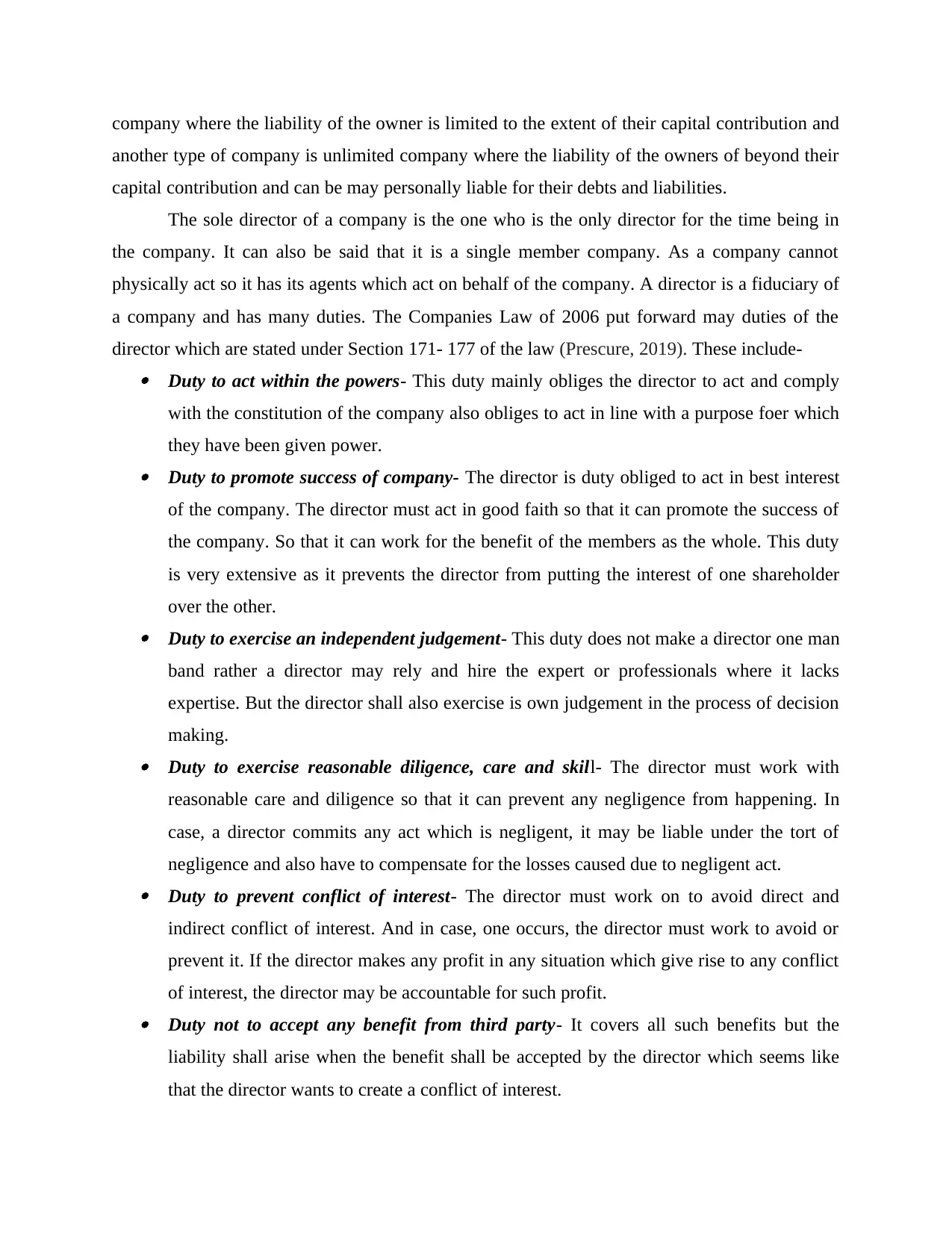
company where the liability of the owner is limited to the extent of their capital contribution and
another type of company is unlimited company where the liability of the owners of beyond their
capital contribution and can be may personally liable for their debts and liabilities.
The sole director of a company is the one who is the only director for the time being in
the company. It can also be said that it is a single member company. As a company cannot
physically act so it has its agents which act on behalf of the company. A director is a fiduciary of
a company and has many duties. The Companies Law of 2006 put forward may duties of the
director which are stated under Section 171- 177 of the law (Prescure, 2019). These include- Duty to act within the powers- This duty mainly obliges the director to act and comply
with the constitution of the company also obliges to act in line with a purpose foer which
they have been given power. Duty to promote success of company- The director is duty obliged to act in best interest
of the company. The director must act in good faith so that it can promote the success of
the company. So that it can work for the benefit of the members as the whole. This duty
is very extensive as it prevents the director from putting the interest of one shareholder
over the other. Duty to exercise an independent judgement- This duty does not make a director one man
band rather a director may rely and hire the expert or professionals where it lacks
expertise. But the director shall also exercise is own judgement in the process of decision
making. Duty to exercise reasonable diligence, care and skill- The director must work with
reasonable care and diligence so that it can prevent any negligence from happening. In
case, a director commits any act which is negligent, it may be liable under the tort of
negligence and also have to compensate for the losses caused due to negligent act. Duty to prevent conflict of interest- The director must work on to avoid direct and
indirect conflict of interest. And in case, one occurs, the director must work to avoid or
prevent it. If the director makes any profit in any situation which give rise to any conflict
of interest, the director may be accountable for such profit. Duty not to accept any benefit from third party- It covers all such benefits but the
liability shall arise when the benefit shall be accepted by the director which seems like
that the director wants to create a conflict of interest.
another type of company is unlimited company where the liability of the owners of beyond their
capital contribution and can be may personally liable for their debts and liabilities.
The sole director of a company is the one who is the only director for the time being in
the company. It can also be said that it is a single member company. As a company cannot
physically act so it has its agents which act on behalf of the company. A director is a fiduciary of
a company and has many duties. The Companies Law of 2006 put forward may duties of the
director which are stated under Section 171- 177 of the law (Prescure, 2019). These include- Duty to act within the powers- This duty mainly obliges the director to act and comply
with the constitution of the company also obliges to act in line with a purpose foer which
they have been given power. Duty to promote success of company- The director is duty obliged to act in best interest
of the company. The director must act in good faith so that it can promote the success of
the company. So that it can work for the benefit of the members as the whole. This duty
is very extensive as it prevents the director from putting the interest of one shareholder
over the other. Duty to exercise an independent judgement- This duty does not make a director one man
band rather a director may rely and hire the expert or professionals where it lacks
expertise. But the director shall also exercise is own judgement in the process of decision
making. Duty to exercise reasonable diligence, care and skill- The director must work with
reasonable care and diligence so that it can prevent any negligence from happening. In
case, a director commits any act which is negligent, it may be liable under the tort of
negligence and also have to compensate for the losses caused due to negligent act. Duty to prevent conflict of interest- The director must work on to avoid direct and
indirect conflict of interest. And in case, one occurs, the director must work to avoid or
prevent it. If the director makes any profit in any situation which give rise to any conflict
of interest, the director may be accountable for such profit. Duty not to accept any benefit from third party- It covers all such benefits but the
liability shall arise when the benefit shall be accepted by the director which seems like
that the director wants to create a conflict of interest.
Paraphrase This Document
Need a fresh take? Get an instant paraphrase of this document with our AI Paraphraser
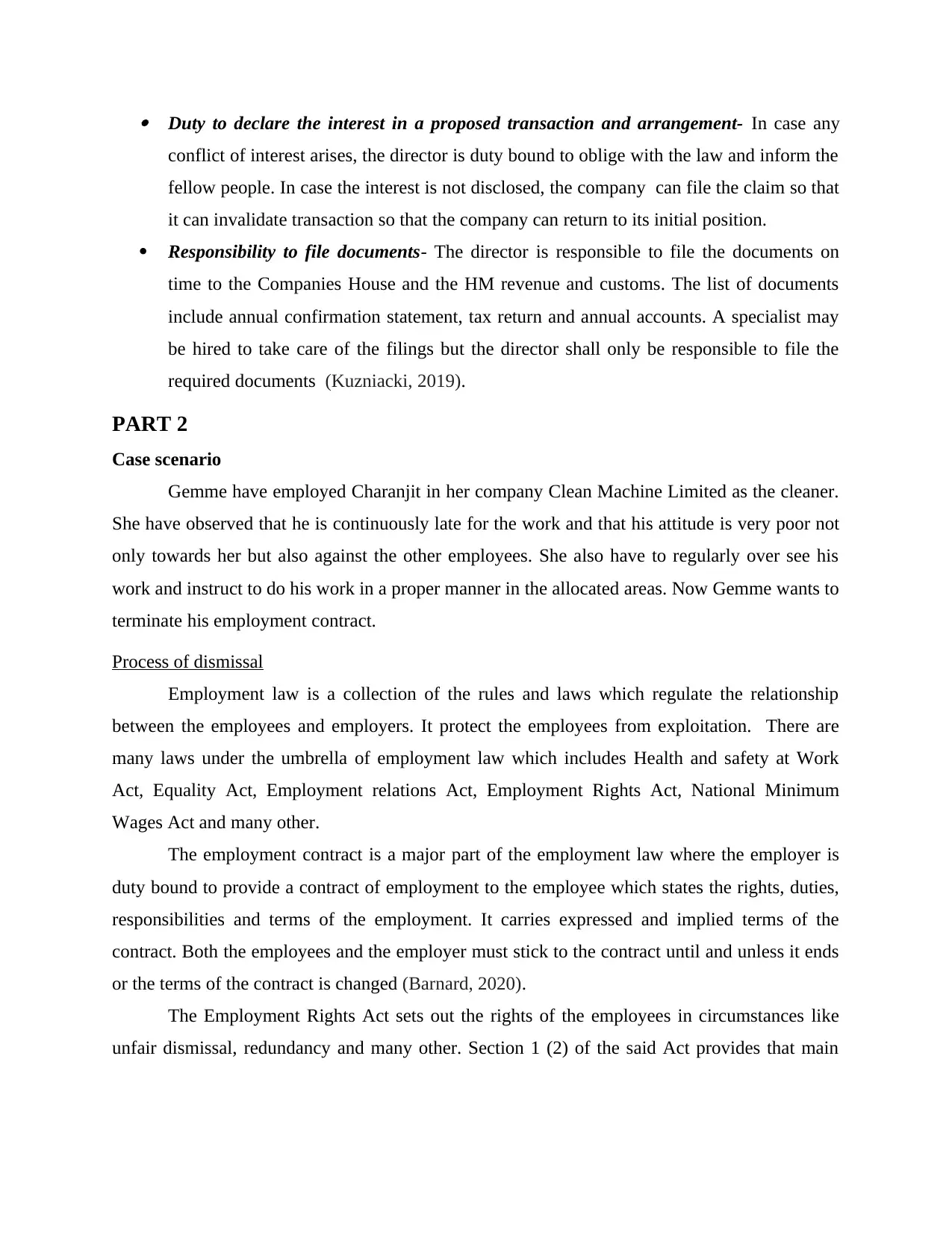
Duty to declare the interest in a proposed transaction and arrangement- In case any
conflict of interest arises, the director is duty bound to oblige with the law and inform the
fellow people. In case the interest is not disclosed, the company can file the claim so that
it can invalidate transaction so that the company can return to its initial position.
Responsibility to file documents- The director is responsible to file the documents on
time to the Companies House and the HM revenue and customs. The list of documents
include annual confirmation statement, tax return and annual accounts. A specialist may
be hired to take care of the filings but the director shall only be responsible to file the
required documents (Kuzniacki, 2019).
PART 2
Case scenario
Gemme have employed Charanjit in her company Clean Machine Limited as the cleaner.
She have observed that he is continuously late for the work and that his attitude is very poor not
only towards her but also against the other employees. She also have to regularly over see his
work and instruct to do his work in a proper manner in the allocated areas. Now Gemme wants to
terminate his employment contract.
Process of dismissal
Employment law is a collection of the rules and laws which regulate the relationship
between the employees and employers. It protect the employees from exploitation. There are
many laws under the umbrella of employment law which includes Health and safety at Work
Act, Equality Act, Employment relations Act, Employment Rights Act, National Minimum
Wages Act and many other.
The employment contract is a major part of the employment law where the employer is
duty bound to provide a contract of employment to the employee which states the rights, duties,
responsibilities and terms of the employment. It carries expressed and implied terms of the
contract. Both the employees and the employer must stick to the contract until and unless it ends
or the terms of the contract is changed (Barnard, 2020).
The Employment Rights Act sets out the rights of the employees in circumstances like
unfair dismissal, redundancy and many other. Section 1 (2) of the said Act provides that main
conflict of interest arises, the director is duty bound to oblige with the law and inform the
fellow people. In case the interest is not disclosed, the company can file the claim so that
it can invalidate transaction so that the company can return to its initial position.
Responsibility to file documents- The director is responsible to file the documents on
time to the Companies House and the HM revenue and customs. The list of documents
include annual confirmation statement, tax return and annual accounts. A specialist may
be hired to take care of the filings but the director shall only be responsible to file the
required documents (Kuzniacki, 2019).
PART 2
Case scenario
Gemme have employed Charanjit in her company Clean Machine Limited as the cleaner.
She have observed that he is continuously late for the work and that his attitude is very poor not
only towards her but also against the other employees. She also have to regularly over see his
work and instruct to do his work in a proper manner in the allocated areas. Now Gemme wants to
terminate his employment contract.
Process of dismissal
Employment law is a collection of the rules and laws which regulate the relationship
between the employees and employers. It protect the employees from exploitation. There are
many laws under the umbrella of employment law which includes Health and safety at Work
Act, Equality Act, Employment relations Act, Employment Rights Act, National Minimum
Wages Act and many other.
The employment contract is a major part of the employment law where the employer is
duty bound to provide a contract of employment to the employee which states the rights, duties,
responsibilities and terms of the employment. It carries expressed and implied terms of the
contract. Both the employees and the employer must stick to the contract until and unless it ends
or the terms of the contract is changed (Barnard, 2020).
The Employment Rights Act sets out the rights of the employees in circumstances like
unfair dismissal, redundancy and many other. Section 1 (2) of the said Act provides that main
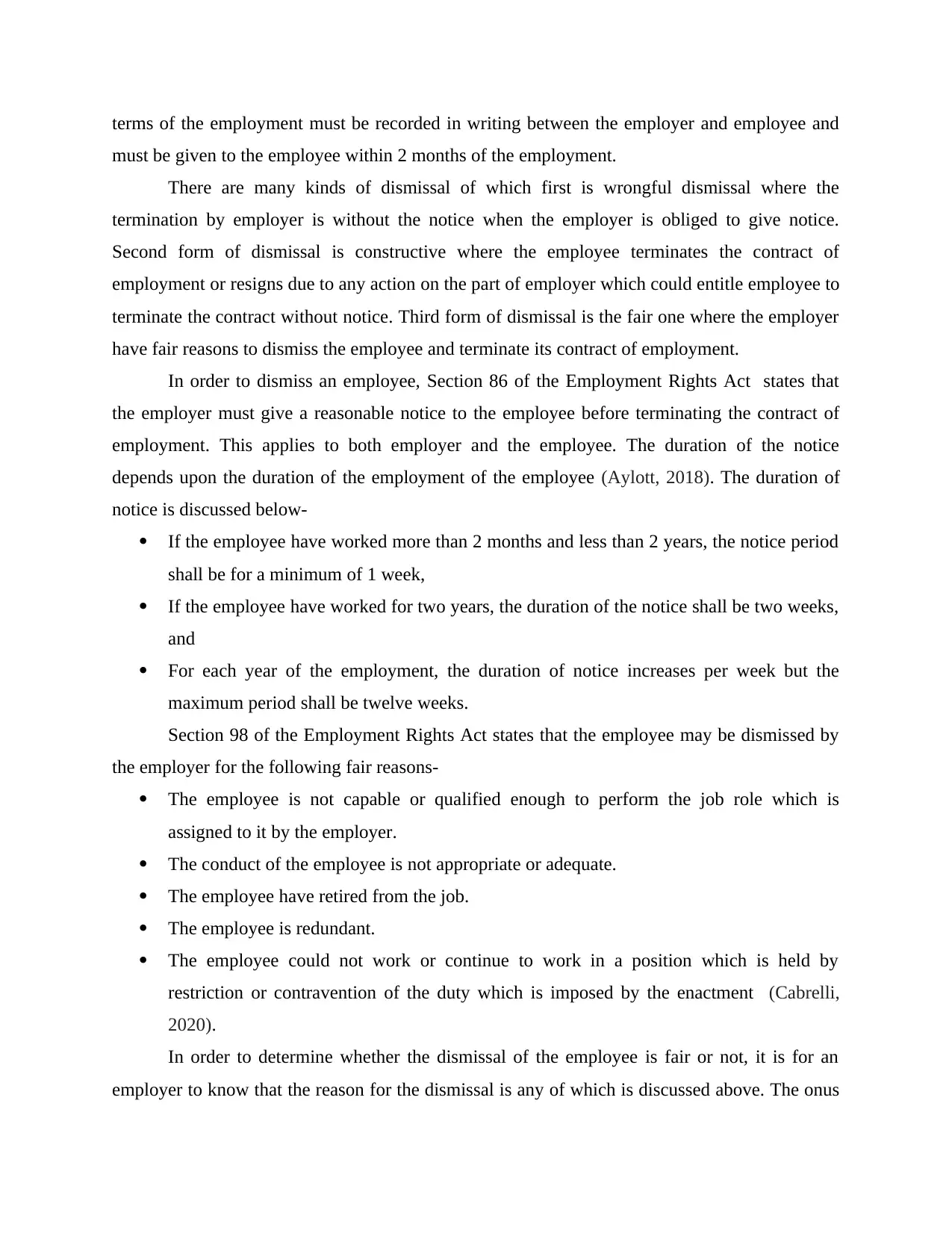
terms of the employment must be recorded in writing between the employer and employee and
must be given to the employee within 2 months of the employment.
There are many kinds of dismissal of which first is wrongful dismissal where the
termination by employer is without the notice when the employer is obliged to give notice.
Second form of dismissal is constructive where the employee terminates the contract of
employment or resigns due to any action on the part of employer which could entitle employee to
terminate the contract without notice. Third form of dismissal is the fair one where the employer
have fair reasons to dismiss the employee and terminate its contract of employment.
In order to dismiss an employee, Section 86 of the Employment Rights Act states that
the employer must give a reasonable notice to the employee before terminating the contract of
employment. This applies to both employer and the employee. The duration of the notice
depends upon the duration of the employment of the employee (Aylott, 2018). The duration of
notice is discussed below-
If the employee have worked more than 2 months and less than 2 years, the notice period
shall be for a minimum of 1 week,
If the employee have worked for two years, the duration of the notice shall be two weeks,
and
For each year of the employment, the duration of notice increases per week but the
maximum period shall be twelve weeks.
Section 98 of the Employment Rights Act states that the employee may be dismissed by
the employer for the following fair reasons-
The employee is not capable or qualified enough to perform the job role which is
assigned to it by the employer.
The conduct of the employee is not appropriate or adequate.
The employee have retired from the job.
The employee is redundant.
The employee could not work or continue to work in a position which is held by
restriction or contravention of the duty which is imposed by the enactment (Cabrelli,
2020).
In order to determine whether the dismissal of the employee is fair or not, it is for an
employer to know that the reason for the dismissal is any of which is discussed above. The onus
must be given to the employee within 2 months of the employment.
There are many kinds of dismissal of which first is wrongful dismissal where the
termination by employer is without the notice when the employer is obliged to give notice.
Second form of dismissal is constructive where the employee terminates the contract of
employment or resigns due to any action on the part of employer which could entitle employee to
terminate the contract without notice. Third form of dismissal is the fair one where the employer
have fair reasons to dismiss the employee and terminate its contract of employment.
In order to dismiss an employee, Section 86 of the Employment Rights Act states that
the employer must give a reasonable notice to the employee before terminating the contract of
employment. This applies to both employer and the employee. The duration of the notice
depends upon the duration of the employment of the employee (Aylott, 2018). The duration of
notice is discussed below-
If the employee have worked more than 2 months and less than 2 years, the notice period
shall be for a minimum of 1 week,
If the employee have worked for two years, the duration of the notice shall be two weeks,
and
For each year of the employment, the duration of notice increases per week but the
maximum period shall be twelve weeks.
Section 98 of the Employment Rights Act states that the employee may be dismissed by
the employer for the following fair reasons-
The employee is not capable or qualified enough to perform the job role which is
assigned to it by the employer.
The conduct of the employee is not appropriate or adequate.
The employee have retired from the job.
The employee is redundant.
The employee could not work or continue to work in a position which is held by
restriction or contravention of the duty which is imposed by the enactment (Cabrelli,
2020).
In order to determine whether the dismissal of the employee is fair or not, it is for an
employer to know that the reason for the dismissal is any of which is discussed above. The onus
⊘ This is a preview!⊘
Do you want full access?
Subscribe today to unlock all pages.

Trusted by 1+ million students worldwide
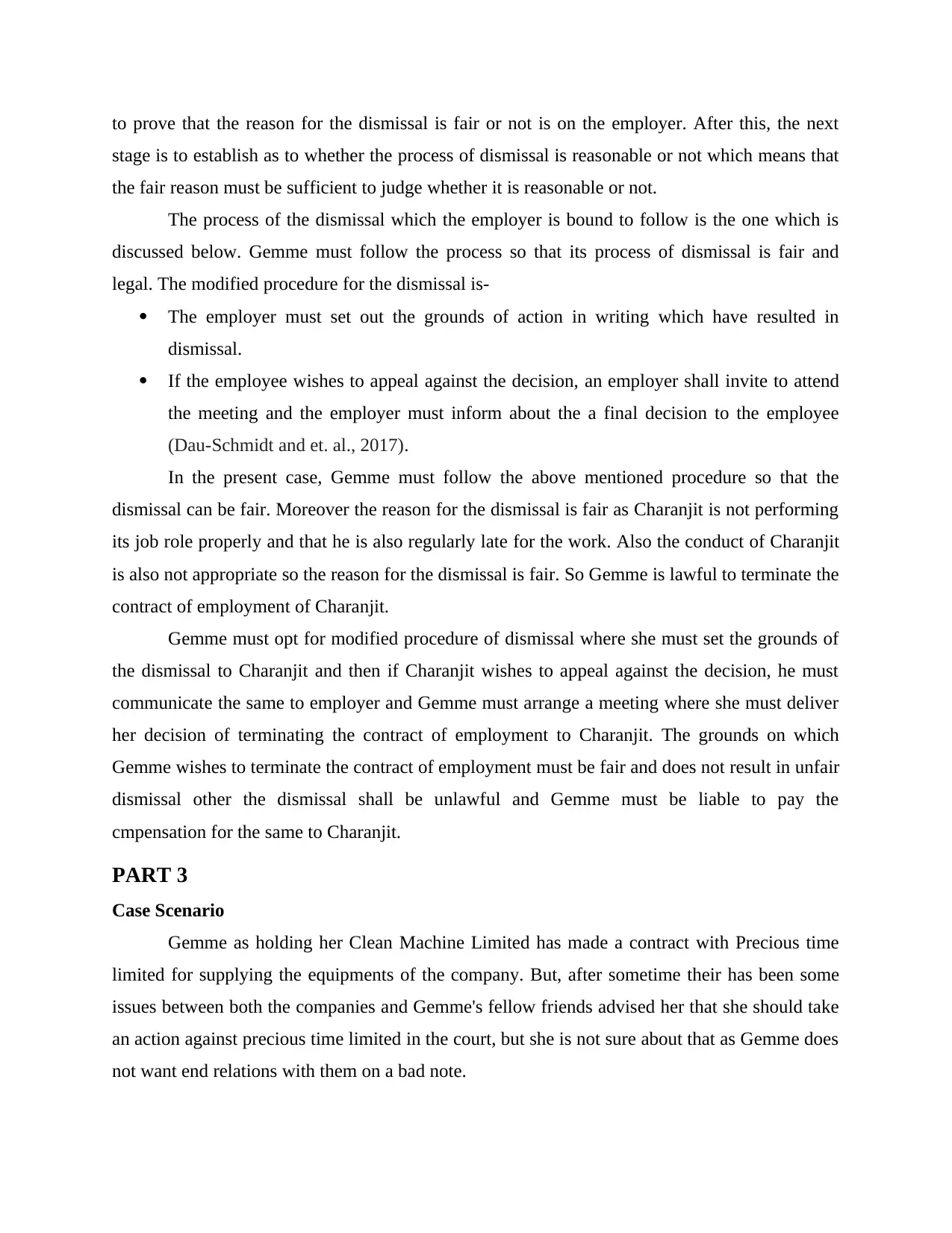
to prove that the reason for the dismissal is fair or not is on the employer. After this, the next
stage is to establish as to whether the process of dismissal is reasonable or not which means that
the fair reason must be sufficient to judge whether it is reasonable or not.
The process of the dismissal which the employer is bound to follow is the one which is
discussed below. Gemme must follow the process so that its process of dismissal is fair and
legal. The modified procedure for the dismissal is-
The employer must set out the grounds of action in writing which have resulted in
dismissal.
If the employee wishes to appeal against the decision, an employer shall invite to attend
the meeting and the employer must inform about the a final decision to the employee
(Dau-Schmidt and et. al., 2017).
In the present case, Gemme must follow the above mentioned procedure so that the
dismissal can be fair. Moreover the reason for the dismissal is fair as Charanjit is not performing
its job role properly and that he is also regularly late for the work. Also the conduct of Charanjit
is also not appropriate so the reason for the dismissal is fair. So Gemme is lawful to terminate the
contract of employment of Charanjit.
Gemme must opt for modified procedure of dismissal where she must set the grounds of
the dismissal to Charanjit and then if Charanjit wishes to appeal against the decision, he must
communicate the same to employer and Gemme must arrange a meeting where she must deliver
her decision of terminating the contract of employment to Charanjit. The grounds on which
Gemme wishes to terminate the contract of employment must be fair and does not result in unfair
dismissal other the dismissal shall be unlawful and Gemme must be liable to pay the
cmpensation for the same to Charanjit.
PART 3
Case Scenario
Gemme as holding her Clean Machine Limited has made a contract with Precious time
limited for supplying the equipments of the company. But, after sometime their has been some
issues between both the companies and Gemme's fellow friends advised her that she should take
an action against precious time limited in the court, but she is not sure about that as Gemme does
not want end relations with them on a bad note.
stage is to establish as to whether the process of dismissal is reasonable or not which means that
the fair reason must be sufficient to judge whether it is reasonable or not.
The process of the dismissal which the employer is bound to follow is the one which is
discussed below. Gemme must follow the process so that its process of dismissal is fair and
legal. The modified procedure for the dismissal is-
The employer must set out the grounds of action in writing which have resulted in
dismissal.
If the employee wishes to appeal against the decision, an employer shall invite to attend
the meeting and the employer must inform about the a final decision to the employee
(Dau-Schmidt and et. al., 2017).
In the present case, Gemme must follow the above mentioned procedure so that the
dismissal can be fair. Moreover the reason for the dismissal is fair as Charanjit is not performing
its job role properly and that he is also regularly late for the work. Also the conduct of Charanjit
is also not appropriate so the reason for the dismissal is fair. So Gemme is lawful to terminate the
contract of employment of Charanjit.
Gemme must opt for modified procedure of dismissal where she must set the grounds of
the dismissal to Charanjit and then if Charanjit wishes to appeal against the decision, he must
communicate the same to employer and Gemme must arrange a meeting where she must deliver
her decision of terminating the contract of employment to Charanjit. The grounds on which
Gemme wishes to terminate the contract of employment must be fair and does not result in unfair
dismissal other the dismissal shall be unlawful and Gemme must be liable to pay the
cmpensation for the same to Charanjit.
PART 3
Case Scenario
Gemme as holding her Clean Machine Limited has made a contract with Precious time
limited for supplying the equipments of the company. But, after sometime their has been some
issues between both the companies and Gemme's fellow friends advised her that she should take
an action against precious time limited in the court, but she is not sure about that as Gemme does
not want end relations with them on a bad note.
Paraphrase This Document
Need a fresh take? Get an instant paraphrase of this document with our AI Paraphraser
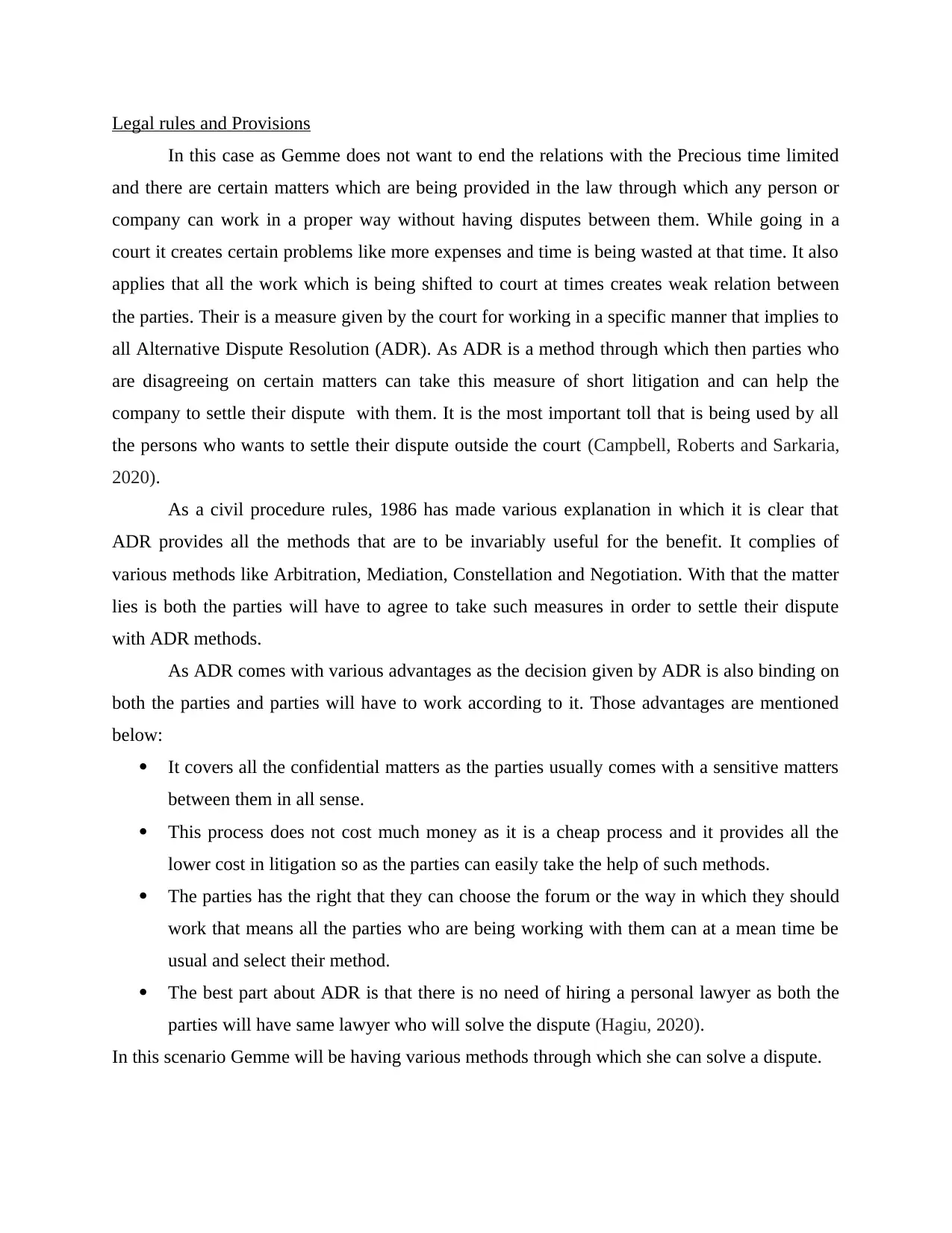
Legal rules and Provisions
In this case as Gemme does not want to end the relations with the Precious time limited
and there are certain matters which are being provided in the law through which any person or
company can work in a proper way without having disputes between them. While going in a
court it creates certain problems like more expenses and time is being wasted at that time. It also
applies that all the work which is being shifted to court at times creates weak relation between
the parties. Their is a measure given by the court for working in a specific manner that implies to
all Alternative Dispute Resolution (ADR). As ADR is a method through which then parties who
are disagreeing on certain matters can take this measure of short litigation and can help the
company to settle their dispute with them. It is the most important toll that is being used by all
the persons who wants to settle their dispute outside the court (Campbell, Roberts and Sarkaria,
2020).
As a civil procedure rules, 1986 has made various explanation in which it is clear that
ADR provides all the methods that are to be invariably useful for the benefit. It complies of
various methods like Arbitration, Mediation, Constellation and Negotiation. With that the matter
lies is both the parties will have to agree to take such measures in order to settle their dispute
with ADR methods.
As ADR comes with various advantages as the decision given by ADR is also binding on
both the parties and parties will have to work according to it. Those advantages are mentioned
below:
It covers all the confidential matters as the parties usually comes with a sensitive matters
between them in all sense.
This process does not cost much money as it is a cheap process and it provides all the
lower cost in litigation so as the parties can easily take the help of such methods.
The parties has the right that they can choose the forum or the way in which they should
work that means all the parties who are being working with them can at a mean time be
usual and select their method.
The best part about ADR is that there is no need of hiring a personal lawyer as both the
parties will have same lawyer who will solve the dispute (Hagiu, 2020).
In this scenario Gemme will be having various methods through which she can solve a dispute.
In this case as Gemme does not want to end the relations with the Precious time limited
and there are certain matters which are being provided in the law through which any person or
company can work in a proper way without having disputes between them. While going in a
court it creates certain problems like more expenses and time is being wasted at that time. It also
applies that all the work which is being shifted to court at times creates weak relation between
the parties. Their is a measure given by the court for working in a specific manner that implies to
all Alternative Dispute Resolution (ADR). As ADR is a method through which then parties who
are disagreeing on certain matters can take this measure of short litigation and can help the
company to settle their dispute with them. It is the most important toll that is being used by all
the persons who wants to settle their dispute outside the court (Campbell, Roberts and Sarkaria,
2020).
As a civil procedure rules, 1986 has made various explanation in which it is clear that
ADR provides all the methods that are to be invariably useful for the benefit. It complies of
various methods like Arbitration, Mediation, Constellation and Negotiation. With that the matter
lies is both the parties will have to agree to take such measures in order to settle their dispute
with ADR methods.
As ADR comes with various advantages as the decision given by ADR is also binding on
both the parties and parties will have to work according to it. Those advantages are mentioned
below:
It covers all the confidential matters as the parties usually comes with a sensitive matters
between them in all sense.
This process does not cost much money as it is a cheap process and it provides all the
lower cost in litigation so as the parties can easily take the help of such methods.
The parties has the right that they can choose the forum or the way in which they should
work that means all the parties who are being working with them can at a mean time be
usual and select their method.
The best part about ADR is that there is no need of hiring a personal lawyer as both the
parties will have same lawyer who will solve the dispute (Hagiu, 2020).
In this scenario Gemme will be having various methods through which she can solve a dispute.
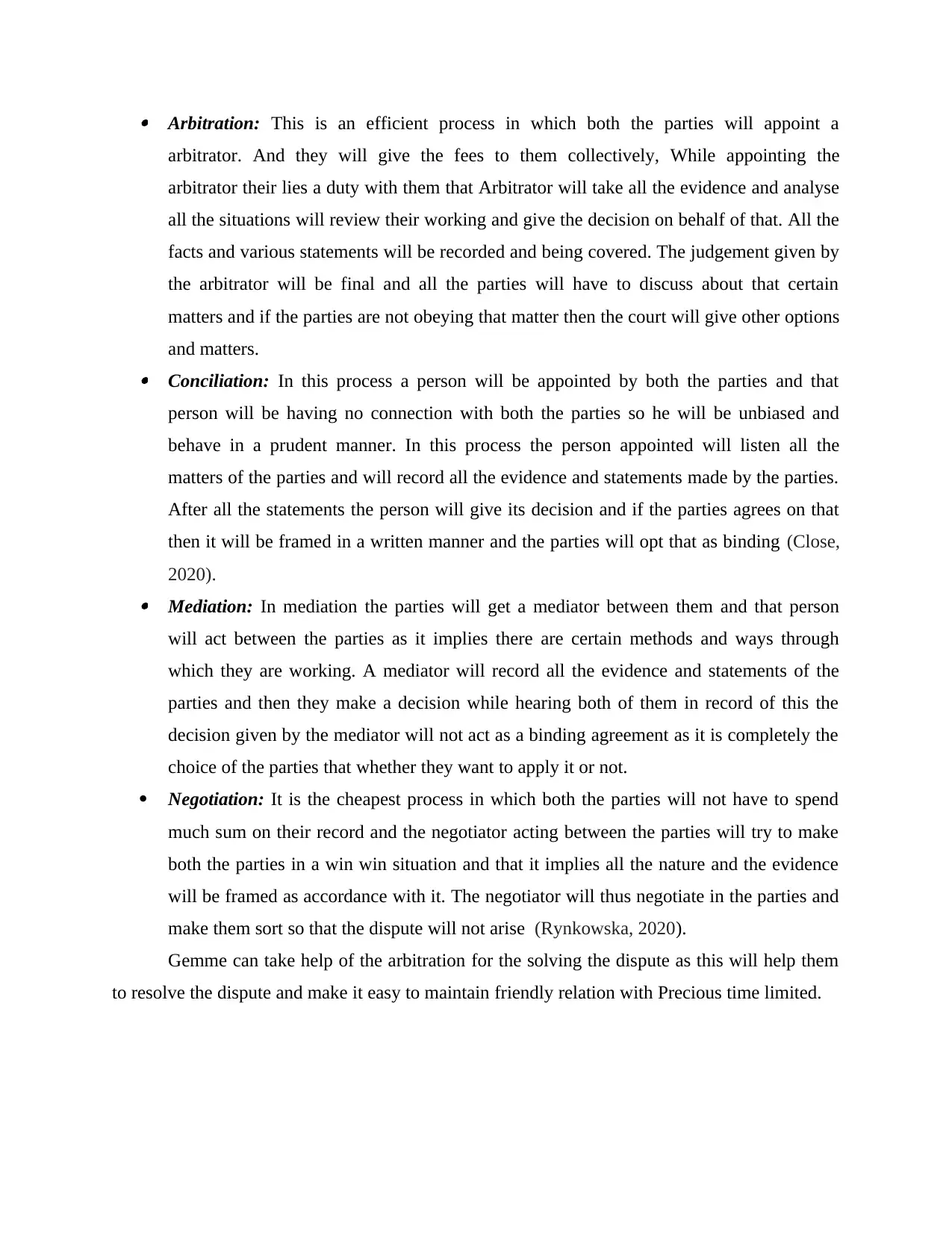
Arbitration: This is an efficient process in which both the parties will appoint a
arbitrator. And they will give the fees to them collectively, While appointing the
arbitrator their lies a duty with them that Arbitrator will take all the evidence and analyse
all the situations will review their working and give the decision on behalf of that. All the
facts and various statements will be recorded and being covered. The judgement given by
the arbitrator will be final and all the parties will have to discuss about that certain
matters and if the parties are not obeying that matter then the court will give other options
and matters. Conciliation: In this process a person will be appointed by both the parties and that
person will be having no connection with both the parties so he will be unbiased and
behave in a prudent manner. In this process the person appointed will listen all the
matters of the parties and will record all the evidence and statements made by the parties.
After all the statements the person will give its decision and if the parties agrees on that
then it will be framed in a written manner and the parties will opt that as binding (Close,
2020). Mediation: In mediation the parties will get a mediator between them and that person
will act between the parties as it implies there are certain methods and ways through
which they are working. A mediator will record all the evidence and statements of the
parties and then they make a decision while hearing both of them in record of this the
decision given by the mediator will not act as a binding agreement as it is completely the
choice of the parties that whether they want to apply it or not.
Negotiation: It is the cheapest process in which both the parties will not have to spend
much sum on their record and the negotiator acting between the parties will try to make
both the parties in a win win situation and that it implies all the nature and the evidence
will be framed as accordance with it. The negotiator will thus negotiate in the parties and
make them sort so that the dispute will not arise (Rynkowska, 2020).
Gemme can take help of the arbitration for the solving the dispute as this will help them
to resolve the dispute and make it easy to maintain friendly relation with Precious time limited.
arbitrator. And they will give the fees to them collectively, While appointing the
arbitrator their lies a duty with them that Arbitrator will take all the evidence and analyse
all the situations will review their working and give the decision on behalf of that. All the
facts and various statements will be recorded and being covered. The judgement given by
the arbitrator will be final and all the parties will have to discuss about that certain
matters and if the parties are not obeying that matter then the court will give other options
and matters. Conciliation: In this process a person will be appointed by both the parties and that
person will be having no connection with both the parties so he will be unbiased and
behave in a prudent manner. In this process the person appointed will listen all the
matters of the parties and will record all the evidence and statements made by the parties.
After all the statements the person will give its decision and if the parties agrees on that
then it will be framed in a written manner and the parties will opt that as binding (Close,
2020). Mediation: In mediation the parties will get a mediator between them and that person
will act between the parties as it implies there are certain methods and ways through
which they are working. A mediator will record all the evidence and statements of the
parties and then they make a decision while hearing both of them in record of this the
decision given by the mediator will not act as a binding agreement as it is completely the
choice of the parties that whether they want to apply it or not.
Negotiation: It is the cheapest process in which both the parties will not have to spend
much sum on their record and the negotiator acting between the parties will try to make
both the parties in a win win situation and that it implies all the nature and the evidence
will be framed as accordance with it. The negotiator will thus negotiate in the parties and
make them sort so that the dispute will not arise (Rynkowska, 2020).
Gemme can take help of the arbitration for the solving the dispute as this will help them
to resolve the dispute and make it easy to maintain friendly relation with Precious time limited.
⊘ This is a preview!⊘
Do you want full access?
Subscribe today to unlock all pages.

Trusted by 1+ million students worldwide
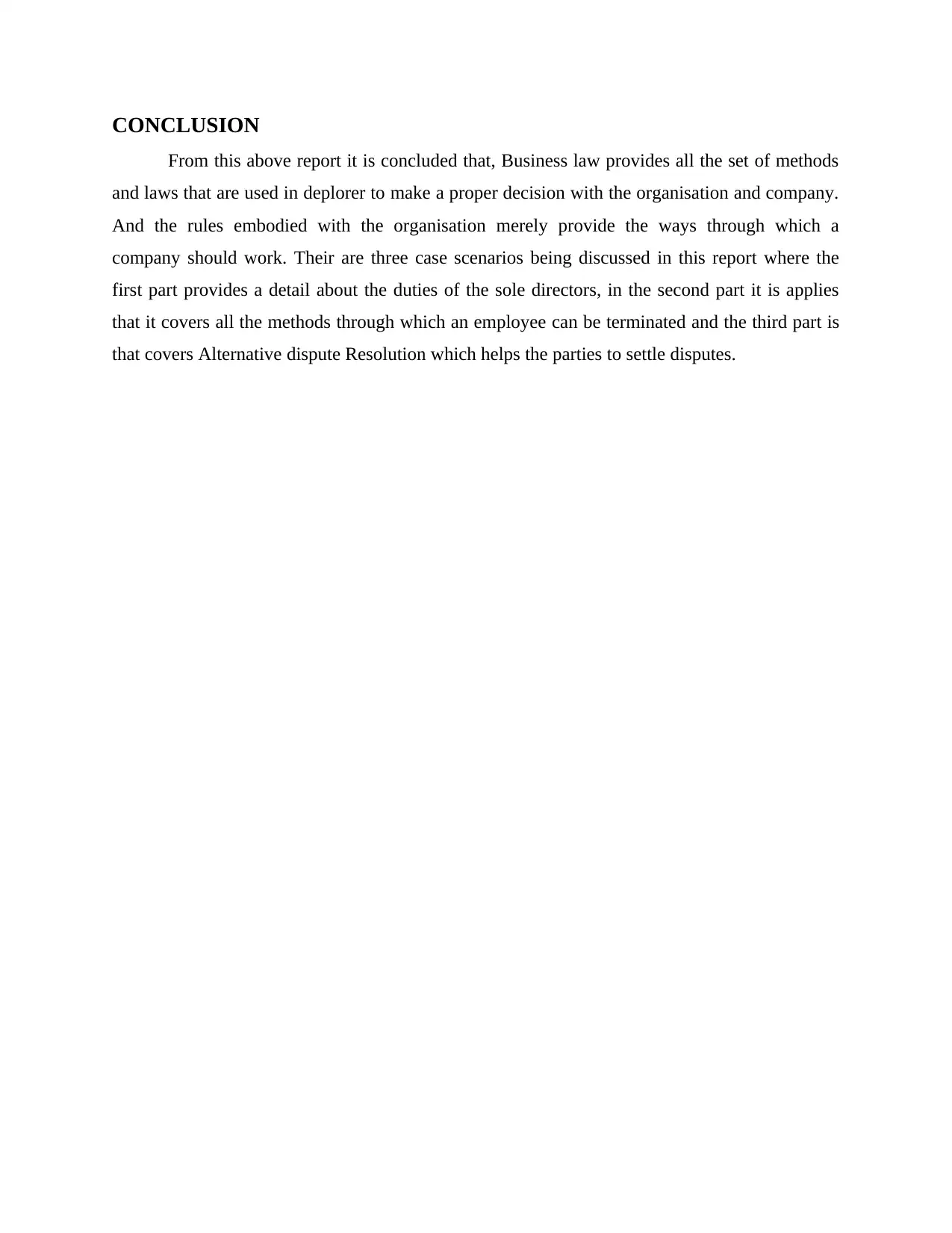
CONCLUSION
From this above report it is concluded that, Business law provides all the set of methods
and laws that are used in deplorer to make a proper decision with the organisation and company.
And the rules embodied with the organisation merely provide the ways through which a
company should work. Their are three case scenarios being discussed in this report where the
first part provides a detail about the duties of the sole directors, in the second part it is applies
that it covers all the methods through which an employee can be terminated and the third part is
that covers Alternative dispute Resolution which helps the parties to settle disputes.
From this above report it is concluded that, Business law provides all the set of methods
and laws that are used in deplorer to make a proper decision with the organisation and company.
And the rules embodied with the organisation merely provide the ways through which a
company should work. Their are three case scenarios being discussed in this report where the
first part provides a detail about the duties of the sole directors, in the second part it is applies
that it covers all the methods through which an employee can be terminated and the third part is
that covers Alternative dispute Resolution which helps the parties to settle disputes.
Paraphrase This Document
Need a fresh take? Get an instant paraphrase of this document with our AI Paraphraser
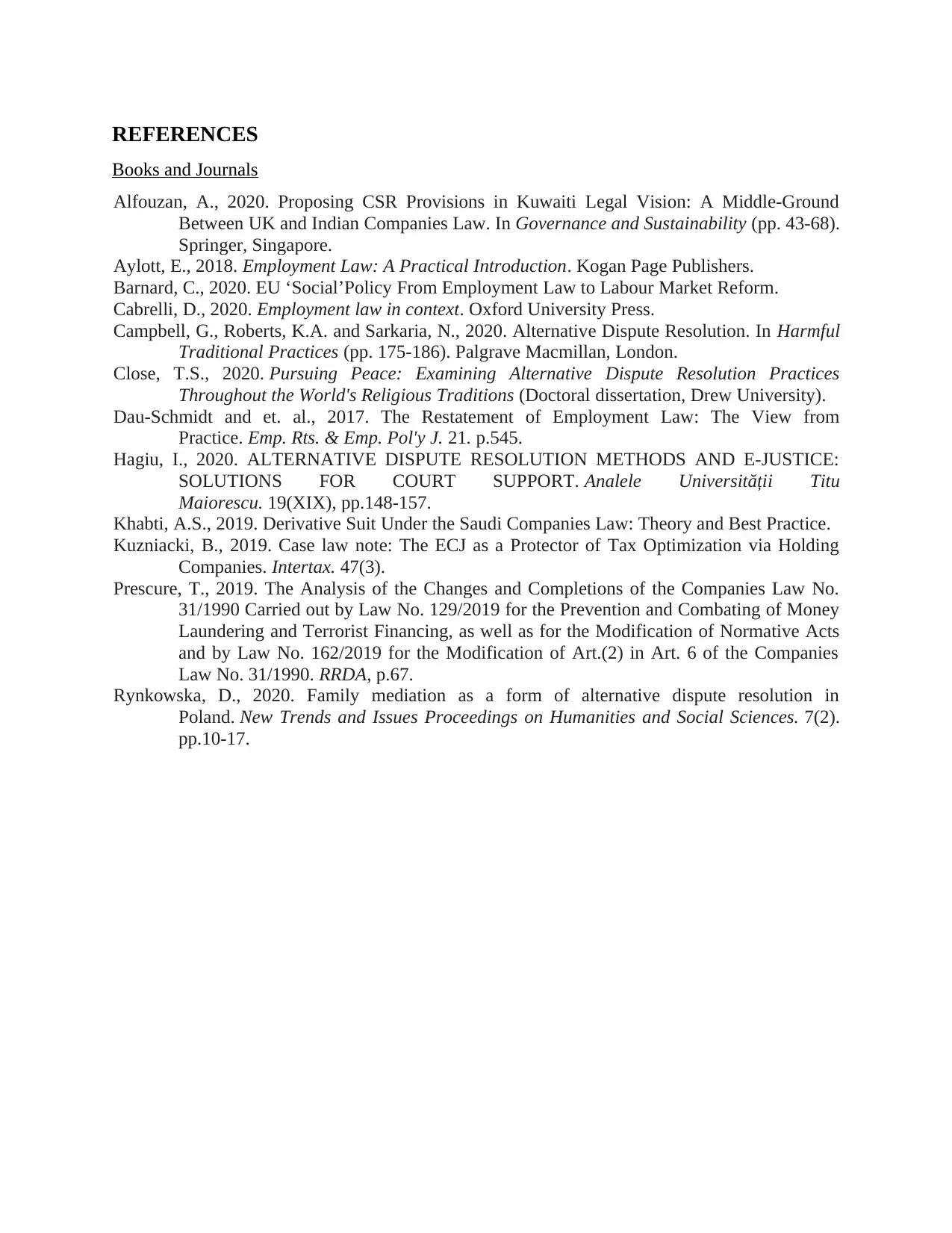
REFERENCES
Books and Journals
Alfouzan, A., 2020. Proposing CSR Provisions in Kuwaiti Legal Vision: A Middle-Ground
Between UK and Indian Companies Law. In Governance and Sustainability (pp. 43-68).
Springer, Singapore.
Aylott, E., 2018. Employment Law: A Practical Introduction. Kogan Page Publishers.
Barnard, C., 2020. EU ‘Social’Policy From Employment Law to Labour Market Reform.
Cabrelli, D., 2020. Employment law in context. Oxford University Press.
Campbell, G., Roberts, K.A. and Sarkaria, N., 2020. Alternative Dispute Resolution. In Harmful
Traditional Practices (pp. 175-186). Palgrave Macmillan, London.
Close, T.S., 2020. Pursuing Peace: Examining Alternative Dispute Resolution Practices
Throughout the World's Religious Traditions (Doctoral dissertation, Drew University).
Dau-Schmidt and et. al., 2017. The Restatement of Employment Law: The View from
Practice. Emp. Rts. & Emp. Pol'y J. 21. p.545.
Hagiu, I., 2020. ALTERNATIVE DISPUTE RESOLUTION METHODS AND E-JUSTICE:
SOLUTIONS FOR COURT SUPPORT. Analele Universității Titu
Maiorescu. 19(XIX), pp.148-157.
Khabti, A.S., 2019. Derivative Suit Under the Saudi Companies Law: Theory and Best Practice.
Kuzniacki, B., 2019. Case law note: The ECJ as a Protector of Tax Optimization via Holding
Companies. Intertax. 47(3).
Prescure, T., 2019. The Analysis of the Changes and Completions of the Companies Law No.
31/1990 Carried out by Law No. 129/2019 for the Prevention and Combating of Money
Laundering and Terrorist Financing, as well as for the Modification of Normative Acts
and by Law No. 162/2019 for the Modification of Art.(2) in Art. 6 of the Companies
Law No. 31/1990. RRDA, p.67.
Rynkowska, D., 2020. Family mediation as a form of alternative dispute resolution in
Poland. New Trends and Issues Proceedings on Humanities and Social Sciences. 7(2).
pp.10-17.
Books and Journals
Alfouzan, A., 2020. Proposing CSR Provisions in Kuwaiti Legal Vision: A Middle-Ground
Between UK and Indian Companies Law. In Governance and Sustainability (pp. 43-68).
Springer, Singapore.
Aylott, E., 2018. Employment Law: A Practical Introduction. Kogan Page Publishers.
Barnard, C., 2020. EU ‘Social’Policy From Employment Law to Labour Market Reform.
Cabrelli, D., 2020. Employment law in context. Oxford University Press.
Campbell, G., Roberts, K.A. and Sarkaria, N., 2020. Alternative Dispute Resolution. In Harmful
Traditional Practices (pp. 175-186). Palgrave Macmillan, London.
Close, T.S., 2020. Pursuing Peace: Examining Alternative Dispute Resolution Practices
Throughout the World's Religious Traditions (Doctoral dissertation, Drew University).
Dau-Schmidt and et. al., 2017. The Restatement of Employment Law: The View from
Practice. Emp. Rts. & Emp. Pol'y J. 21. p.545.
Hagiu, I., 2020. ALTERNATIVE DISPUTE RESOLUTION METHODS AND E-JUSTICE:
SOLUTIONS FOR COURT SUPPORT. Analele Universității Titu
Maiorescu. 19(XIX), pp.148-157.
Khabti, A.S., 2019. Derivative Suit Under the Saudi Companies Law: Theory and Best Practice.
Kuzniacki, B., 2019. Case law note: The ECJ as a Protector of Tax Optimization via Holding
Companies. Intertax. 47(3).
Prescure, T., 2019. The Analysis of the Changes and Completions of the Companies Law No.
31/1990 Carried out by Law No. 129/2019 for the Prevention and Combating of Money
Laundering and Terrorist Financing, as well as for the Modification of Normative Acts
and by Law No. 162/2019 for the Modification of Art.(2) in Art. 6 of the Companies
Law No. 31/1990. RRDA, p.67.
Rynkowska, D., 2020. Family mediation as a form of alternative dispute resolution in
Poland. New Trends and Issues Proceedings on Humanities and Social Sciences. 7(2).
pp.10-17.
1 out of 11
Related Documents
Your All-in-One AI-Powered Toolkit for Academic Success.
+13062052269
info@desklib.com
Available 24*7 on WhatsApp / Email
![[object Object]](/_next/static/media/star-bottom.7253800d.svg)
Unlock your academic potential
Copyright © 2020–2025 A2Z Services. All Rights Reserved. Developed and managed by ZUCOL.





